Evidence for Simultaneous Dearomatization of Two Aromatic Rings under Mild Conditions in Cu(I)-Catalyzed Direct Asymmetric Dearomatization of Pyridine
- PMID: 32453952
- PMCID: PMC8171382
- DOI: 10.1021/jacs.0c04486
Evidence for Simultaneous Dearomatization of Two Aromatic Rings under Mild Conditions in Cu(I)-Catalyzed Direct Asymmetric Dearomatization of Pyridine
Abstract
Bis(phosphine) copper hydride complexes are uniquely able to catalyze direct dearomatization of unactivated pyridines with carbon nucleophiles, but the mechanistic basis for this result has been unclear. Here we show that, contrary to our initial hypotheses, the catalytic mechanism is monometallic and proceeds via dearomative rearrangement of the phenethylcopper nucleophile to a Cpara-metalated form prior to reaction at heterocycle C4. Our studies support an unexpected heterocycle-promoted pathway for this net 1,5-Cu-migration beginning with a doubly dearomative imidoyl-Cu-ene reaction. Kinetics, substituent effects, computational modeling, and spectroscopic studies support the involvement of this unusual process. In this pathway, the CuL2 fragment subsequently mediates a stepwise Cope rearrangement of the doubly dearomatized intermediate to the give the C4-functionalized 1,4-dihydropyridine, lowering a second barrier that would otherwise prohibit efficient asymmetric catalysis.
Conflict of interest statement
The authors declare no competing financial interests.
Figures
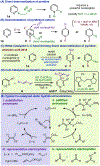
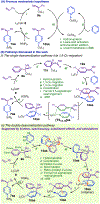
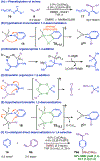
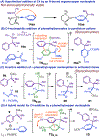
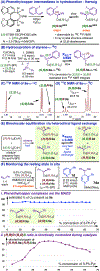





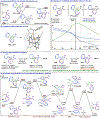





Similar articles
-
Asymmetric Cu-Catalyzed 1,4-Dearomatization of Pyridines and Pyridazines without Preactivation of the Heterocycle or Nucleophile.J Am Chem Soc. 2018 Apr 18;140(15):5057-5060. doi: 10.1021/jacs.8b02568. Epub 2018 Apr 6. J Am Chem Soc. 2018. PMID: 29609461 Free PMC article.
-
Designing a Cu(II)-ArCu(II)-ArCu(III)-Cu(I) catalytic cycle: Cu(II)-catalyzed oxidative arene C-H bond azidation with air as an oxidant under ambient conditions.J Org Chem. 2014 Nov 21;79(22):11139-45. doi: 10.1021/jo502115a. Epub 2014 Nov 5. J Org Chem. 2014. PMID: 25350606
-
Highly enantioselective nitrone cycloadditions with 2-alkenoyl pyridine N-oxides catalyzed by Cu(II)-BOX complexes.Org Lett. 2011 Feb 4;13(3):402-5. doi: 10.1021/ol102716e. Epub 2010 Dec 22. Org Lett. 2011. PMID: 21175140
-
Copper-Promoted Functionalization of Organic Molecules: from Biologically Relevant Cu/O2 Model Systems to Organometallic Transformations.Chem Rev. 2019 Feb 27;119(4):2954-3031. doi: 10.1021/acs.chemrev.8b00368. Epub 2019 Jan 30. Chem Rev. 2019. PMID: 30698952 Free PMC article. Review.
-
Recent Progresses in the Catalytic Stereoselective Dearomatization of Pyridines.Molecules. 2023 Aug 22;28(17):6186. doi: 10.3390/molecules28176186. Molecules. 2023. PMID: 37687015 Free PMC article. Review.
Cited by
-
Chloride-Mediated Alkene Activation Drives Enantioselective Thiourea and Hydrogen Chloride Co-Catalyzed Prins Cyclizations.J Am Chem Soc. 2022 Aug 31;144(34):15812-15824. doi: 10.1021/jacs.2c06688. Epub 2022 Aug 22. J Am Chem Soc. 2022. PMID: 35994741 Free PMC article.
-
Organoborohydride-catalyzed Chichibabin-type C4-position alkylation of pyridines with alkenes assisted by organoboranes.Chem Sci. 2020 Sep 29;11(42):11554-11561. doi: 10.1039/d0sc04808a. Chem Sci. 2020. PMID: 34094401 Free PMC article.
-
Reaction strategies for the meta-selective functionalization of pyridine through dearomatization.Mol Divers. 2025 Feb;29(1):849-869. doi: 10.1007/s11030-024-10861-5. Epub 2024 Apr 22. Mol Divers. 2025. PMID: 38647989 Review.
-
Recent Strategies in the Nucleophilic Dearomatization of Pyridines, Quinolines, and Isoquinolines.Chem Rev. 2024 Feb 14;124(3):1122-1246. doi: 10.1021/acs.chemrev.3c00625. Epub 2024 Jan 2. Chem Rev. 2024. PMID: 38166390 Free PMC article. Review.
-
Predictable C-H Functionalization of Complex beta-Fused Azines: A Mechanistically Bound Site-Specific Oxidation.ACS Cent Sci. 2025 Jul 1;11(7):1189-1198. doi: 10.1021/acscentsci.5c00797. eCollection 2025 Jul 23. ACS Cent Sci. 2025. PMID: 40726791 Free PMC article.
References
-
-
For reviews on pyridine dearomatization and dihydropyridine chemistry, see:
- Lavilla R Recent Developments in the Chemistry of Dihydropyridines. J. Chem. Soc., Perkin Trans 1, 2002, 1141–1156.
- Ahamed M; Todd MH Catalytic Asymmetric Additions of Carbon-Centered Nucleophiles to Nitrogen-Containing Aromatic Heterocycles. Eur. J. Org. Chem 2010, 2010, 5935–5942.
- Bull JA; Mousseau JJ; Pelletier G; Charette AB Synthesis of Pyridine and Dihydropyridine Derivatives by Regio- and Stereoselective Addition to N-Activated Pyridines. Chem. Rev 2012, 112, 2642–2713. - PubMed
- Zhuo C-X; Zhang W; You S-L Catalytic Asymmetric Dearomatization Reactions. Angew. Chem. Int. Ed 2012, 51, 12662–12686. - PubMed
- Ding Q; Zhou X; Fan R Recent Advances in Dearomatization of Heteroaromatic Compounds. Org. Biomol. Chem 2014, 12, 4807–4815. - PubMed
- Bertuzzi G; Bernardi L; Fochi M Nucleophilic Dearomatization of Activated Pyridines. Catalysts 2018, 8, 632–665.
-
-
- Vitaku E; Smith DT; Njardarson JT Analysis of the Structural Diversity, Substitution Patterns, and Frequency of Nitrogen Heterocycles among U.S. FDA Approved Pharmaceuticals. J. Med. Chem 2014, 57, 10257–10274. - PubMed
-
- Comins DL; Abdullah AH Regioselective Addition of Grignard Reagents to 1-Acylpyridinium Salts. A Convenient Method for the Synthesis of 4-Alkyl(aryl)pyridines. J. Org. Chem 1982, 47, 4315–4319.
-
-
Reports on catalyzed direct addition of hydride or silyl nucleophiles to pyridine had appeared in preceding years and some are conceptually related to the Cu-catalyzed asymmetric dearomatization; the reaction with styrenes in Figure 1, D, can be viewed formally as a diverted 1,4-hydrosilylation of pyridine in which the hydride is intercepted by an olefin to generate a carbon-centered nucleophile rather than undergoing attack at heterocycle C4. See
- Oshima K; Ohmura T; Suginome M Palladium-Catalyzed Regioselective Silaboration of Pyridines Leading to the Synthesis of Silylated Dihydropyridines. J. Am. Chem. Soc 2011, 133, 7324–7327. - PubMed
- Gutsulyak DV; van der Est A; Nikonov GI Facile Catalytic Hydrosilylation of Pyridines. Angew. Chem. Int. Ed 2011, 50, 1384–1387. - PubMed
- Hill MS; Kociok-Köhn G; MacDougall DJ; Mahon MF; Weetman C Magnesium Hydrides and the Dearomatisation of Pyridine and Quinoline derivatives. Dalton Trans 2011, 40, 12500–12509. - PubMed
- Königs CDF; Klare HFT; Oestreich M Catalytic 1,4-Selective Hydrosilylation of Pyridines and Benzannulated Congeners. Angew. Chem. Int. Ed 2013, 52, 10076–10079. - PubMed
- Dudnik AS; Weidner VL; Motta A; Delferro M; Marks TJ Nat. Chem 2014, 6, 1100–1107. - PubMed
- Gandhamsetty N; Park S; Chang S Atom-Efficient Regioselective 1,2-Dearomatization of Functionalized Pyridines by an Earth-Abundant Organolanthanide Catalyst. J. Am. Chem. Soc 2015, 137, 15176–15184. - PubMed
- Intemann J; Bauer H; Pahl J; Maron L; Harder S Calcium Hydride Catalyzed Highly 1,2-Selective Pyridine Hydrosilylation. Chem. Eur. J 2015, 21, 11452–11461. - PubMed
- Fan X; Zheng J; Li ZH; Wang H Organoborane Catalyzed Regioselective 1,4-Hydroboration of Pyridines. J. Am. Chem. Soc 2015, 137, 4916–4919. - PubMed
- Kaithal A; Chatterjee B; Gunanathan C Ruthenium-Catalyzed Regioselective 1,4-Hydroboration of Pyridines. Org. Lett 2016, 18, 3402–3405. - PubMed
- Zhang F; Song H; Zhuang X; Tung C-H; Wang W Iron-Catalyzed 1,2-Selective Hydroboration of N-Heteroarenes. J. Am. Chem. Soc, 2017, 139, 17775–17778. - PubMed
- Yu H-C; Islam SM; Mankad NP Cooperative Heterobimetallic Substrate Activation Enhances Catalytic Activity and Amplifies Regioselectivity in 1,4-Hydroboration of Pyridines. ACS Catal 2020, 10, 3670–3675.
-
Publication types
MeSH terms
Substances
Grants and funding
LinkOut - more resources
Full Text Sources
Miscellaneous

